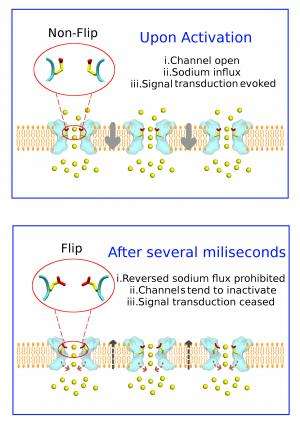Computer simulations visualize ion flux

Ion channels are involved in many physiological and pathophysiological processes throughout the human body. A young team of researchers led by pharmacologist Anna Stary-Weinzinger from the Department of Pharmacology and Toxicology, University of Vienna investigated how ion flux through a voltage gated sodium ion channel works in detail. Since this process is incredibly fast (up to 100 million ions per seconds), computer simulations were performed to visualize sodium flux "in slow motion". The time consuming calculations were performed using the high performance computer cluster (VSC), which is currently the fastest computer in Austria. Recently, the results were published in PLOS Computational Biology.
Electrical signals, generated by voltage gated ion channels are essential for survival. Without these proteins, fundamental body functions such as heart beat, signal transduction in our brain, or muscle contraction would not be possible.
A remarkable feature of these extraordinary proteins is that they enable extremely rapid and selective ion flux. X-ray structures provided tremendous insights into the structure of these proteins. Guided by this structural information, investigating the details of ion selectivity and conductance becomes feasible. Crystal structures revealed a short, water filled "ion filter" structure at the extracellular side of the protein, surrounded by four negatively charged glutamic acid side chains, which enables selective sodium flux. However, from these "static" structures it is not easy to deduce how the dynamic process of ion flux works in detail. Thus, computer simulations are a great means to provide mechanistic insights into this process.
Computer simulations visualize ion movements
To watch these fascinating proteins at work, computer simulations, so called molecular dynamics simulations were performed. With the help of the fastest high performance computer in Austria, the Vienna Scientific Cluster (VSC), detailed insights into the mechanism of sodium flux became possible. A team of researchers from the Department of Pharmacology and Toxicology in Vienna discovered that ion influx from the extracellular environment is much faster compared to ion efflux. "The reason behind this remarkable difference lies in the fact that a key amino acid, glutamic acid 53 undergoes a rotational movement ('flip'), thereby modulating ion flux", explains doctoral student Song Ke.
Glutamic acid (E53) regulates channel flux
Molecular dynamics simulations reveal that one specific amino acid, E53, has two distinct configurations depending on the ion flux directions. "E53 allows a large amount of sodium influx, when it is in the non-flipped, outward-facing state. Free energy calculations revealed that efflux is much harder for the ions, due to a 'barrier', which slows ion movement. Thus, to help ions 'overcome' this barrier and to enable efflux of sodium ions, the E53 side chain flips to an inward-facing conformation", explains Song Ke, PhD student from the University of Vienna. Further, we consider it likely that the flipped glutamic acid could play a substantial role in triggering channel inactivation, a key mechanism to allow repolarization of the membrane.
More information: S. Ke, E. N. Timin, A. Stary-Weinzinger: "Different Inward and Outward Conduction Mechanisms in NaVMs Suggested by Molecular Dynamics Simulations." PLOS Computational Biology, July 2014. DOI: 10.1371/journal.pcbi.1003746
Journal information: PLoS Computational Biology
Provided by University of Vienna



















